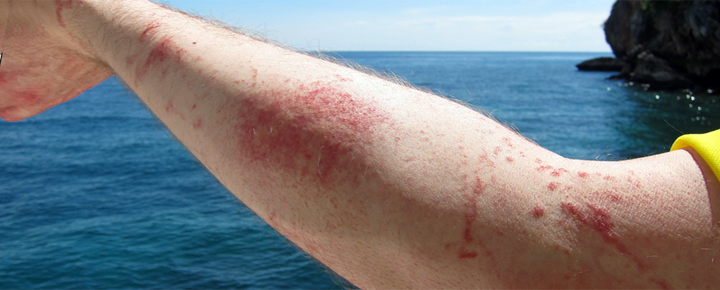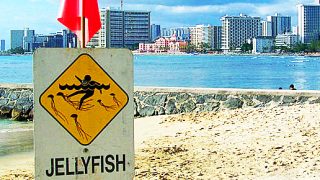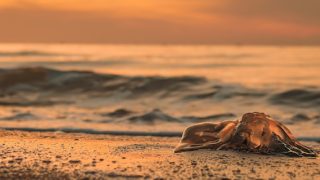When elite athletes faced unexpected jellyfish stings during the 2024 Ironman World Championship in Kona, it raised a critical question: could this happen to Hawaii’s millions of annual visitors? The stings left seasoned competitors, including Menno Koolhaas and Matt Burton, grappling with intense pain as they pushed through one of the world’s toughest and most renowned endurance races. For everyday beachgoers, the incident underscored the need to respect and be aware of Hawaii’s ocean risks.
With 2025’s jellyfish calendar now available, understanding this ocean hazard is crucial for anyone planning a trip to Hawaii’s stunning beaches. Awareness can make all the difference, whether swimming, snorkeling or simply enjoying the water. Having been stung before, BOH editors can tell you firsthand—it’s an experience you’ll want to avoid at all costs. Let us help you stay jellyfish safe!


Jellyfish chaos at Ironman Kona.
During the swim portion of the 2024 Ironman World Championship, athletes encountered an unanticipated jellyfish invasion in Kailua Bay. Despite their physical conditioning and mental preparation, many struggled with the stings, which can feel like something between electrical shocks and severe burns. Commenter Diane L., who experienced a sting while on her vacation, described it as “Like a lot of bee stings, only worse.”
If jellyfish can disrupt a world-class sporting event, what does that mean for the millions of annual visitors who flock to Hawaii’s beaches? Unlike the controlled environment of a race, tourists don’t have immediate medical staff or pre-planned safety measures. This makes prior understanding of jellyfish behavior even more vital.
Why do jellyfish invade Hawaii’s beaches?
Hawaii’s box jellyfish are a fascinating and frustrating natural phenomenon. These creatures are tied to the lunar cycle, with their appearances peaking 8 to 10 days after a full moon. Drawn by tidal changes, they wash ashore in large numbers, particularly along southern beaches like Waikiki and Ala Moana on Oahu, as well as Poipu Beach on Kauai, Kaʻanapali Beach on Maui, and Hapuna Beach on the Big Island. While most visitors associate Hawaii’s beaches with tranquility, jellyfish can turn a serene swim into a painful memory.
Kaley R. highlighted how easy it is to get caught off guard: “Yes! So bad today!” Similarly, Jennifer A. shared her encounter in Wailea: “Lots of little ones on the beach and in the water. Ouch!”
Adding to the unpredictability, different jellyfish species can appear unexpectedly, driven by strong winds. As JP commented, “October and November have brought in early man o’ war… They are staying longer, with warm water and wind keeping them around.”


The 2025 jellyfish calendar.
To help residents and visitors plan safer beach days, the Waikiki Aquarium has published its 2025 Box Jellyfish Calendar. These estimated dates highlight the periods when box jellyfish are most likely to be near Hawaii beaches:
- January 21-23
- February 19-21
- March 21-23
- April 19-21
- May 19-21
- June 17-19
- July 17-19
- August 15-17
- September 14-16
- October 14-16
- November 12-14
- December 12-14
While these dates provide a general guideline, jellyfish may appear outside these windows. Melissa shared a practical tip: “I arrange my travel to avoid being on the islands 10 days following a full moon. So far, this has been a successful plan.” That’s a great idea, and BOH editors try to do the same.
Visitors should also look for posted warning signs or consult lifeguards before swimming. As Diane L. noted after her sting, “They should have warned us, at the least!” Many travelers echo this sentiment and feel better communication about risks could improve beach safety.


Staying safe and avoiding stings.
Jellyfish stings are no minor inconvenience. Symptoms can range from burning pain to nausea, swelling, and even difficulty breathing. Knowing how to treat a sting is essential for minimizing discomfort and preventing complications.
First, avoid rinsing with fresh water, which can trigger additional venom release. Instead, some recommend using vinegar to neutralize toxins and removing tentacles with tweezers or gloves to avoid further contact. We’ll refer you to Mayo Clinic’s page on jellyfish sting treatment.
For more severe reactions, like those described by Syl B., professional medical help is crucial: “I had terrible muscle spasms for 2-3 days… My whole body felt weird, and I threw up multiple times.” These experiences highlight the importance of taking stings seriously, especially for those with allergies or pre-existing conditions.
What Ironman taught us about Hawaii’s ocean risks.
The Ironman jellyfish incident isn’t just a story about elite athletes—it’s a reminder for everyone, including visitors and residents, to respect Hawaii’s natural environment. Whether competing in a race or enjoying a family vacation, understanding the risks associated with jellyfish can help prevent unpleasant surprises.
John A. recounted a frightening encounter from his childhood: “My mom stepped on a man o’ war… Her breathing became almost non-existent. It’s no joke—knowing what to do could save your life.” His story underscores the importance of education and preparation for visitors and Hawaii’s residents.
Embracing Hawaii’s beauty with situational awareness.
Hawaii’s beaches are among the most beautiful worldwide, and millions of visitors enjoy them safely yearly. Travelers can fully embrace the islands’ ocean magic while minimizing risks by staying informed about jellyfish patterns, respecting ocean safety guidelines, and knowing how to respond in case of a jellyfish sting.
As Jan, a longtime Honolulu resident, advised visitors, “Try to book your trip avoiding the monthly influx—it usually lasts four days. Good luck and enjoy. Aloha.”
We’ve already received hundreds of comments from visitors about their experiences with jellyfish in Hawaii, and we’ve included a selection of them here.
Please add your thoughts, too. We’d love to hear about your tips, encounters, or questions in the comments below.
Get Breaking Hawaii Travel News






Are there no stinger suits in Hawaii like we had to wear in Australia?
Windward side of Oahu is where I was first stung by a man o’ war in the early ’50s …
Windward side of Oahu is where I’m keeping my sting-string intact, having been stung there again this past summer …
Too much Aloha …
34 years ago I was told stay out of the ocean 8 to 10 days after the full moon because that’s when they show up. Only one time did I forget and paid for it with a sting on my forehead and ex2 ended up with a bunch of stings down the front of her suit!
Seems like event coordinators should have inspected the water for issues like this prior to starting the iron man marathon event. Being a race what is one contestant to do? Just Stop. I guess this just emphasizes the term enter at your own risk.
I was one of the catchers waiting for the swimmers this year. We knew there were jellyfish there and swimmers were told of them. There were people with spray bottles to spray the swimmer who had stings. I directed a swimmer when he came out of the water after being stung. Hopefully the spraying helped. He had a long day ahead of him. I hope he felt better as he biked.
The article missed the scientific reason why jellyfish are getting more common throughout the world. Near shore ocean enrichment by organic matter created by the biped parasite. In Hawaii it is markedly worse because of the thousands of uninspected cesspools. Probably 50% or more of the Hawaiian Isles wastewater is “treated” by hole in the ground called a cesspool. Since this waste seeps into porous volcanic soil, it goes straight to the ocean. Ever wonder why the is “always” a brown water alert after a major rainstorm for most of islands? Until there is more serious enforcement of the Clean Water Act, it will continue and only get worse. Don’t expect any action on this problem under you know who.
Help me understand-
“Don’t expect any action on this problem under you know who.”
Are the past and present ‘you know who’ blameless?
Seriously!? This is a natural phenomena that No human or politician has any control over whatsoever and never will! This is quite simply a problem that can be avoided by anyone that wants to be in the ocean.
Rob, I agree that the past and present are factors in this problem. The past as Hawaii never had strict regulation in wastewater discharge and the present because government no longer cares about the environment. If you know history, the Clean Water Act was passed under Nixon.
It’s going to be a nightmare converting to a septic system in all this lava rock. Talk about expensive! Many islanders are living at the lower end of the wage continuum. The state and federal government are going to have to step in with subsidies instead of leaving the expense solely on the backs of the average lower income homeowner. That’s one of the reasons we have o’hanas in our houses. Multiple families have to live together in order to survive on the islands.
Go to Maui. It’s not really in the travel path of the box jellies. It’s very rare to see box jellies on Maui beaches. It’s really more of an Oahu thing.
And wear a wetsuit if you are really worried about it.
For bad stings a short course of prednisone will be helpful.
There are lots of ’emergency clinics’ all over the islands that can help.
Obviously, November 15th being a Full Moon, south facing beaches would be in harms-way through the 25th. It’s easy enough to consult the Calendar when making plans if beach and water are one’s choice. I’ve always followed that schedule and in 95 trips to Hawaii since ‘86, never had an issue. The cautionary tale, also would be, I don’t consider Kaanapali a south facing beach, so the window should include the water in general.